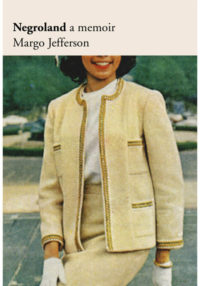I still find “Negro” a word of wonders, glorious and terrible
 Negroland: a Memoir
Negroland: a Memoir
by Margo Jefferson
This is an unusual memoir. It’s heavily stylised, experimental even, but it’s also rather scholarly in its approach to the historical context of Jefferson’s own life.
Margo Jefferson was born in 1947 and raised in a well-to-do black family in Chicago, part of a black elite society with its own specific rules, norms and challenges. And this is what she documents. It’s an unusual subject for a memoir, and in keeping with that, often doesn’t feel like a memoir at all. Jefferson doesn’t bare her soul, or reveal any shocking family secrets. She doesn’t even stick to first person, slipping in and out of referring to herself in the third person.
There is a lot of background information provided about the formation of America’s black elite, which at first felt a little excessive and/or dry until I realised how recent it all was, and in fact most of the people she refers to turn out to be family friends. There is also a lot about physical appearance – how people with different types of hair handled it, how nuances of skin colour and facial shape could affect your place in society. Usually I could not be less interested in hair and make-up, but of course its relevance to this story is rather different. Because even though Jefferson was and is rich, educated and well-connected, she and her friends and family cannot get away from the fact that they are black and therefore different.
“I’m a chronicler of Negroland, a participant-observer, an elegist, dissenter and admirer; sometime expatriate, ongoing interlocuter. I call it Negroland because I still find “Negro” a word of wonders, glorious and terrible. A word for runaway slave posters and civil rights proclamations; for social constructs and street corner taunts. A tonal-language word whose meaning shifts as setting and context shift, as history twists, lurches, advances, and stagnates. As capital letters appear to enhance its dignity; as other nomenclatures arise to challenge its primacy.”
This was highlighted in small ways and larger ones. Women in Jefferson’s community were encouraged to have their own careers – not because they were intrinsically feminist but because black men face the likelihood of suddenly losing their job due to racism, because black men are more likely to go to prison and stay there longer than white men. Family and friends with paler skin would sometimes choose to live “as white” and cut all ties to the black community, maybe visiting covertly very occasionally, then suddenly resurface “as black” on retirement. Jefferson does not pass judgement on these people, acknowledging that they were able to live a life she simply couldn’t.
I found Jefferson’s story got much more interesting for me towards the end of the book, in her post-university years when she stopped keeping herself apart from activism – stopped deeming it more important to fit in, to meet expectations. As I have heard other black women recount, she then felt she had to choose between women’s rights and black rights, and to her the latter was a man’s fight.
“All the bright young faces, generations of them, learning the standard race curriculum of wounds and grievances! The advance or demise of The Race depends on what you do, what you are, what you long to be. That was our fact, that was our fear. Will the generations that come after be at all exempt? Will they show the damage too many of us inherited? Or acquired. Or drove ourselves toward.”
But fitting in wasn’t about choosing the easiest path. It was about survival. While Jefferson was shielded by her privilege, she still experienced the kind of everyday racism that we might these days call microaggressions. She looks back on those moments with dignity and honesty.
I found this book informative but it kept me at a distance. Despite the flourishes of originality, its tone was just a little too scholarly. That said, the writing is beautiful and intelligent.
Published 2016 by Granta Books.
Source: Arnolfini, Bristol.